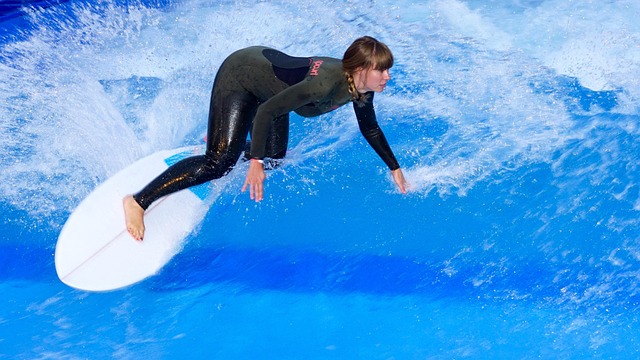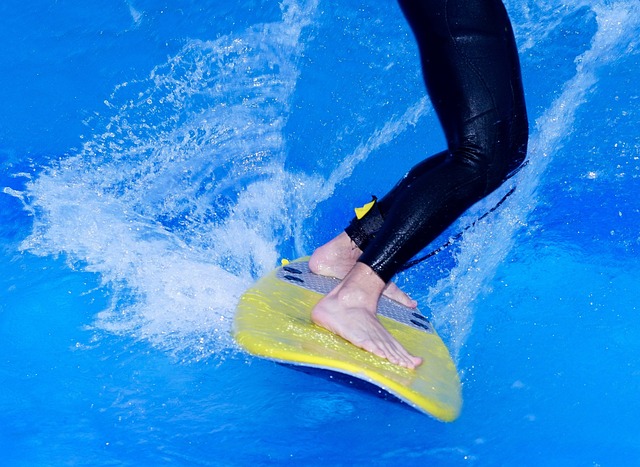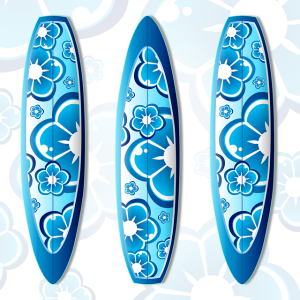Choosing between epoxy and fiberglass finishes for a surfboard as a beginner depends on performance, budget, and skill level. Epoxy provides superior strength, flexibility, durability, and vibrant colors but is more expensive and requires specialized application. Fiberglass offers a traditional, cost-effective option with customizable patterns, good buoyancy, and straightforward construction, ideal for newcomers honing their surfing skills. Beginners should balance these factors, considering epoxy's resilience for better control and fiberglass's accessibility for budget-conscious options. Correct application and maintenance are crucial to ensure optimal performance and longevity of surfboards for beginners, involving proper preparation, ventilation, cleaning, and waxing.
“Looking to build your first surfboard? Understanding the finish is key. This comprehensive guide dives into the world of surfboard coatings, focusing on epoxy and fiberglass—two popular choices for beginners. Learn about the unique benefits and drawbacks of each material, from durability to ease of application. By the end, you’ll be equipped to make an informed decision and choose the perfect finish for your rookie surfboard.”
Understanding Surfboard Finishes: An Overview

For surfboard beginners, understanding the different finishes available is a crucial step in choosing the right board. Surfboard finishes play a significant role in determining the board’s performance and durability, which are essential factors for new surfers to consider. Two popular options are epoxy and fiberglass.
Epoxy finishes offer superior strength and flexibility, making them ideal for surfboards designed to withstand heavy use. This type of finish is known for its vibrant colors and ability to provide a smooth, glass-like surface. On the other hand, fiberglass finishes are more traditional and cost-effective. They are less flexible than epoxy but still offer good protection and come in various weaves and patterns, allowing surfers to personalize their boards’ aesthetics. For beginners, understanding these options will help them make an informed decision based on their skill level, budget, and aesthetic preferences.
What Is Epoxy Finish?

Epoxy finish is a protective coating that offers exceptional durability and shine, making it a popular choice for various surfaces, including surfboards designed for beginners. It’s composed of two components—a resin and a hardener—that, when mixed together, initiate a chemical reaction, hardening to create a robust, smooth layer. This multi-purpose finish is renowned for its ability to fill tiny gaps and bind tightly to different materials, ensuring a long-lasting, water-resistant barrier.
For surfboards, an epoxy finish provides not just aesthetic appeal but also practical benefits. It safeguards the board’s structure from moisture absorption, which can weaken its fibers over time. Moreover, its glossy surface enhances visibility in the water, aiding beginners in tracking their path and improving overall control while riding the waves.
The Advantages of Using Epoxy for Beginners

For surfboard enthusiasts, especially those new to the sport, choosing the right finish can make all the difference in their overall experience and performance on the waves. Epoxy offers a range of advantages for beginners looking to craft or repair their surfboards. Firstly, it’s known for its exceptional durability and strength, making it an ideal choice for creating high-performance boards that can withstand the rigors of regular use and the harsh marine environment. This longevity ensures that your surfboard for beginners remains in top condition for longer, providing value for your investment.
Additionally, epoxy allows for greater customization and design flexibility compared to other finishes. Beginners can easily experiment with different colors and patterns, creating a unique and personalized surfboard. The smooth and glassy finish of epoxy not only enhances the aesthetic appeal but also reduces surface friction, contributing to better control and maneuverability in the water. This characteristic is particularly beneficial for learners who are still developing their skills, as it enables them to focus on techniques without being hindered by the board’s performance.
Fiberglass: A Traditional Option for Surfboards

Fiberglass has long been a traditional option for surfboards, especially among experienced surfers and professionals. Its durability and strength make it an ideal material for high-performance boards designed to withstand intense waves and prolonged use in the ocean. For beginners, however, fiberglass can be overkill; its rigid structure might not offer the same level of forgiveness and ease of manoeuvre that softer materials provide.
Choosing a surfboard made of fiberglass is often suitable for more advanced surfers looking to customise their boards or those seeking specific performance characteristics. But for newcomers to surfing, lighter and more flexible options like epoxy-resin construction can be better suited. These alternatives allow beginners to learn the sport without being bogged down by a heavy board that requires more skill to control.
Comparison: Epoxy vs Fiberglass for Durability and Performance

When it comes to choosing a finish for your surfboard, especially if you’re a beginner, understanding the differences between epoxy and fiberglass is key. Both options offer excellent protection for your board, but they have distinct characteristics that can impact durability and performance.
Epoxy finishes are renowned for their superior strength-to-weight ratio, making them ideal for high-performance surfboards. They are flexible, resistant to impact damage, and provide an exceptional bond with the board’s core material. This flexibility contributes to better resilience against cracks and breaks, which is particularly beneficial for beginners who may be less experienced in handling their boards carefully. On the other hand, fiberglass finishes offer a more traditional approach. While they might not match epoxy’s strength, fiberglass sheets are readily available and cost-effective, making them a popular choice for budget-conscious surfers or those building their first board. Fiberglass also provides good protection against water absorption, ensuring your surfboard remains lighter and stiffer over time.
How to Choose Between Epoxy and Fiberglass for Your First Surfboard

When it comes to choosing between epoxy and fiberglass for your first surfboard, there are several key considerations as a beginner. Epoxy offers exceptional strength-to-weight ratio and durability, making it an excellent choice for high-performance boards. It’s also easier to repair and can be customized with vibrant colors and designs. However, epoxy is more expensive than fiberglass and requires specialized skills for application.
On the other hand, fiberglass is more affordable and widely used in surfboard construction due to its accessibility and versatility. It provides a smooth finish and good buoyancy, making it suitable for beginners who are still learning to catch waves. While not as strong or light as epoxy, fiberglass is less prone to shattering and offers a straightforward construction process, making it ideal for those new to surfboard building.
Application Process: Step-by-Step Guide for Epoxy Finish

Application Process: Step-by-Step Guide for Epoxy Finish
For a surfboard for beginners, an epoxy finish offers both durability and a sleek, professional look. The application process involves several steps that require patience and precision. Start by cleaning the surfboard thoroughly to ensure the surface is free of any debris or dust. This step is crucial as it promotes better adhesion. Next, mix the epoxy resin and hardener according to the manufacturer’s instructions. A common ratio is 2:1, but always double-check the packaging for accurate proportions. Once mixed, apply a thin coat of epoxy using a roller or brush, ensuring even distribution across the board’s surface. Allow this initial layer to dry completely, which typically takes around 24 hours.
After the first coat has hardened, sand the surface gently with fine-grit sandpaper to create a smooth texture. This step helps to remove any air bubbles and imperfections from the previous layer. Clean the board again to remove any dust generated during sanding. Now, apply additional coats of epoxy, following the same process of mixing, applying, drying, and sanding until you achieve your desired finish. For a beginner’s surfboard, two to three coats should suffice. The final step is to let the epoxy cure completely, usually for 24-48 hours, before using or sealing the board as needed.
Common Mistakes to Avoid When Using Epoxy or Fiberglass

When working with epoxy or fiberglass, especially for a surfboard for beginners, there are several common mistakes to avoid. One of the most frequent errors is improper mixing of resins and hardeners. It’s crucial to strictly adhere to the manufacturer’s recommended ratios and mixing times to ensure optimal curing. Using too much hardener can weaken the final product, while an insufficient amount may result in a slow cure that’s prone to imperfections.
Another mistake to steer clear of is inadequate preparation of the surfboard surface. Before applying epoxy or fiberglass, thoroughly clean and roughen the board’s surface using appropriate abrasives. Failure to do so can lead to poor adhesion, bubbles, and an uneven finish. Additionally, ensure proper ventilation during the application process to avoid inhalation of harmful fumes from resins and hardeners.
Maintenance Tips for Longest-Lasting Surfboard Finish

Maintaining your surfboard finish is crucial, especially if you’re new to surfing and want your board to last. For epoxy or fiberglass finishes, regular cleaning and protection are key. After each surf session, rinse your board with fresh water to remove salt and sand residue. Avoid using harsh soaps or scrubs as they can damage the finish; a gentle cleanser is best.
For long-term protection, apply a high-quality wax every few weeks. This creates a barrier against UV rays, prevents fading, and repels water. Keep your board stored in a cool, dry place when not in use to minimize exposure to elements that can degrade the finish. These simple steps will ensure your surfboard for beginners has a durable, protective coat, extending its lifespan and keeping it looking vibrant.
